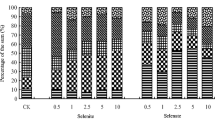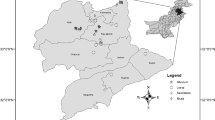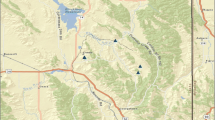Abstract
Depending on the soil environment, selenium (Se) can exist as several species differing greatly in bioavailability. Characterization of soil Se reserves is thus necessary in assessing the nutritional supply of this essential element. In low-Se areas, Se fertilization is an option for securing adequate Se nutrition. Fertilization is, however, challenged by the unknown fate of the residual Se. In this study, we aimed to clarify the Se status of selenate-fertilized field soils by fractionating soil Se into five pools: salt-soluble (KCl), adsorbed (KH2PO4/K2HPO4), organically associated (NaOH), elemental (Na2SO3) and recalcitrant Se (NaOCl). Changes induced in these fractions by repeated application of low selenate doses were examined by comparing samples collected from the same locations in 1992 and 2004. The distribution of Se among the five fractions was relatively similar in all soils. On average, 1% of the amount of Se acquired was salt-soluble, 17% adsorbed, 39% organically associated, 14% elemental and 29% recalcitrant organic Se or metal selenides. The added Se was distributed among several fractions, leading to a relatively small change in each fraction. However, in mineral soils (n = 5), a significant increase in soil Se concentration was found between 1992 and 2004 in adsorbed, organically associated and recalcitrant Se, as well as in the total amount of Se acquired as a sum of the fractions. Our findings provide the first field-scale experimental support for the theoretical assumption of accumulation of residual selenate in acidic mineral soil in insoluble form.


Similar content being viewed by others
References
Balistrieri LS, Chao TT (1987) Selenium adsorption by goethite. Soil Sci Soc Am J 51:1145–1151
Camps Arbestein M (1998) Effect of straw amendment and plant growth on selenium transfer in a laboratory soil-plant system. Can J Soil Sci 78:187–195
Camps Arbestein M, Rodríguez Arós A (2001) Modeling selenium transfers in straw-amended soils. Soil Sci 166:539–547
Cary EE, Wieczorek A, Allaway WH (1967) Reactions of selenite-selenium added to soils that produce low-selenium forages. Soil Sci Soc Am Proc 31:21–26
Combs GF Jr (2001) Selenium in global food systems. Br J Nutr 85:517–547
Coppin F, Chabroullet C, Martin-Garin A, Balesdent J, Gaudet JP (2006) Methodological approach to assess the effect of soil ageing on selenium behaviour: first results concerning mobility and solid fractionation of selenium. Biol Fert Soils 42:379–386
Darcheville O, Février L, Haichar FZ, Berge O, Martin-Garin A, Renault P (2008) Aqueous, solid and gaseous partitioning of selenium in an oxic sandy soil under different microbiological states. J Environ Radioact 99:981–992
Elonen P (1971) Particle-size analysis of soil. Acta Agr Fenn 122:1–122
Elrashidi MA, Adriano DC, Workman SM, Lindsay WL (1987) Chemical equilibria of selenium in soils: a theoretical development. Soil Sci 144:141–152
Eurola M, Alfthan G, Aro A, Ekholm P, Hietaniemi V, Rainio H, Rankanen R, Venäläinen E-R (2003) Results of the Finnish selenium monitoring program 2000–2001. Agrifood Res Rep, report no 36, 42pp
Eurola M, Alfthan G, Ekholm P, Levonmäki M, Root T, Venäläinen E-R, Ylivainio K (2008) Results of the Finnish selenium monitoring program 2008. Maa- ja elintarviketalous 132. (in Finnish, with English Abstract)
Garbisu C, Ishii T, Leighton T, Buchanan BB (1996) Bacterial reduction of selenite to elemental selenium. Chem Geol 132:199–204
Girling CA (1984) Selenium in agriculture and the environment. Agr Ecosyst Environ 11:37–65
Gustafsson JP, Johnsson L (1992) Selenium retention in the organic matter of Swedish forest soils. J Soil Sci 43:461–472
Hamdy AA, Gissel-Nielsen G (1976) Fractionation of soil selenium. Z Pflanz. Bodenkunde 139:697–703
Hingston FJ, Atkinson RJ, Posner AM, Quirk JP (1967) Specific adsorption of anions. Nature 215:1459–1461
Hingston FJ, Posner AM, Quirk JP (1974) Anion adsorption by goethite and gibbsite II. Desorption of anions from hydrous oxide surfaces. J Soil Sci 25:16–26
Hunter WJ, Manter DK (2008) Bio-reduction of selenite to elemental red selenium. Curr Microbiol 57:83–88
Keskinen R, Ekholm P, Yli-Halla M, Hartikainen H (2009) Efficiency of different methods in extracting selenium from agricultural soils of Finland. Geoderma 153:87–93
Keskinen R, Turakainen M, Hartikainen H (2010) Plant availability of soil selenate additions and selenium distribution within wheat and ryegrass. Plant Soil 333:301–313
Koljonen T (1975) The behavior of selenium in Finnish soils. Ann Agr Fenn 14:240–247
Kumpulainen J, Raittila A-M, Lehto J, Koivistoinen P (1983) Electrothermal atomic absorption spectrometric determination of selenium in foods and diets. J Assoc Off Ana Chem 66:1129–1135
Lark LM (2009) Estimating the regional mean status and change of soil properties: two distinct objectives for soil survey. Eur J Soil Sci 60:748–756
Levander OA, Whanger PD (1996) Deliberations and evaluations of the approaches, endpoints and paradigms for selenium and iodine dietary recommendations. J Nutr Suppl 126:2427–2434
Mäkelä-Kurtto R, Eurola M, Laitonen A (2007) Monitoring programme of Finnish arable land Aqua regia extractable trace elements in cultivated soils in 1998. Agrifood Res Rep, report no 104, 61pp
Ministry of Agriculture and Forestry (1984) Proposal for the addition of selenium to fertilizers. Working group report no 7. Helsinki (in Finnish)
Parfitt RL (1978) Anion adsorption by soils and soil materials. Adv Agron 30:1–50
Rajan SSS (1979) Adsorption of selenite, phosphate and sulphate on hydrous alumina. J Soil Sci 30:709–718
Rājan SSS, Watkinson JH (1976) Adsorption of selenite and phosphate on an allophane clay. Soil Sci Soc Am J 40:51–54
Rawlins BG, Scheib AJ, Lark RM, Lister TR (2009) Sampling and analytical plus subsampling variance components for five soil indicators observed at regional scale. Eur J Soil Sci 60:740–747
Rayman MP (2004) The use of high-selenium yeast to raise selenium status: how does it measure up? Brit J Nutr 92:557–573
Saha UK, Liu C, Kozak LM, Huang PM (2004) Kinetics of selenite adsorption on hydroxyaluminium- and hydroxyaluminosilicate-montmorillonite complexes. Soil Sci Soc Am J 68:1197–1209
Sippola J (1979) Selenium content of soils and timothy (Phleum pratense L.) in Finland. Ann Agr Fenn 18:182–187
Sors TG, Ellis DR, Salt DE (2005) Selenium uptake, translocation, assimilation and metabolic fate in plants. Photosynth Res 86:373–389
Sposito G, Yang A, Neal RH, Mackzum A (1991) Selenate reduction in an alluvial soil. Soil Sci Soc Am J 55:1597–1602
Thomson CD (2004) Assessment of requirements for selenium and adequacy of selenium status: a review. Eur J Clin Nutr 58:391–402
Urvas L (1995) Monitoring nutrient and heavy-metal concentrations in cultivated land. Maatalouden tutkimuskeskus Tiedote 15/95. (in Finnish, with English Abstract)
Varo P, Koivistoinen P (ed) (1980) Mineral element composition of Finnish foods XII General discussion and nutritional evaluation. In: Koivistoinen P (ed) Mineral element composition of Finnish foods: N, K, Ca, Mg, P, S, Fe, Cu, Mn, Zn, Mo, Co, Ni, Cr, F, Se, Si, Rb, Al, B, Br, Hg, As, Cd, Pb and Ash. Acta Agr Scand Suppl 22:165–171
Wright MT, Parker DR, Amrhein C (2003) Critical evaluation of the ability of sequential extraction procedures to quantify discrete forms of selenium in sediments and soils. Environ Sci Technol 37:4709–4716
Yläranta T (1982) Volatilization and leaching of selenium added to soils. Ann Agr Fenn 21:103–113
Yläranta T (1983a) The hydride method for measuring the selenium content of plants. Ann Agr Fenn 22:18–28
Yläranta T (1983b) Selenium in Finnish agricultural soils. Ann Agr Fenn 22:122–136
Yläranta T (1985) Increasing the selenium content of cereal and grass crops in Finland. Academic dissertation. University of Helsinki, Finland
Yli-Halla M (2005) Influence of selenium fertilization on soil selenium status. Proceedings: twenty years of selenium fertilization, September 8–9, 2005 Helsinki, Finland. Agrifood Res Rep 69:25–32
Zhang Y, Moore JN (1996) Selenium fractionation and speciation in a wetland system. Environ Sci Technol 30:2613–2619
Acknowledgments
We are grateful to the Finnish Ministry of Agriculture and Forestry, Suoviljelysyhdistys ry and the Finnish Cultural Foundation for financial support and to Mr. Harri Lilja, MSc. and Mr. Jaakko Heikkinen, MSc., for assistance with Fig. 1.
Author information
Authors and Affiliations
Corresponding author
Rights and permissions
About this article
Cite this article
Keskinen, R., Räty, M. & Yli-Halla, M. Selenium fractions in selenate-fertilized field soils of Finland. Nutr Cycl Agroecosyst 91, 17–29 (2011). https://doi.org/10.1007/s10705-011-9435-3
Received:
Accepted:
Published:
Issue Date:
DOI: https://doi.org/10.1007/s10705-011-9435-3




